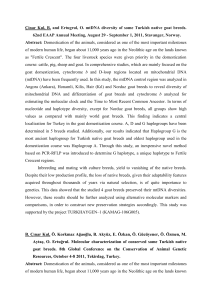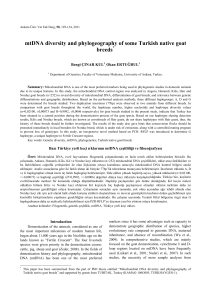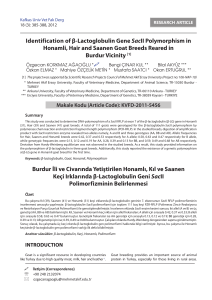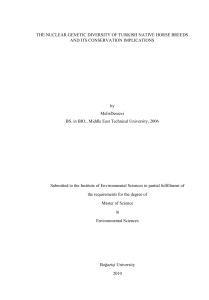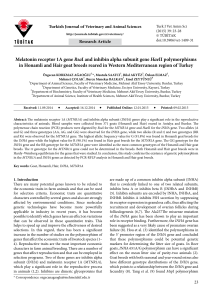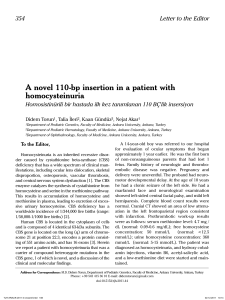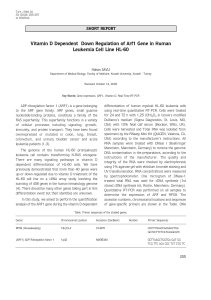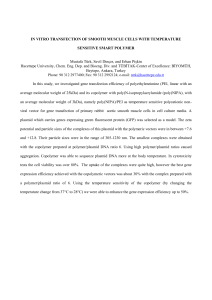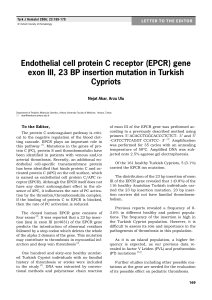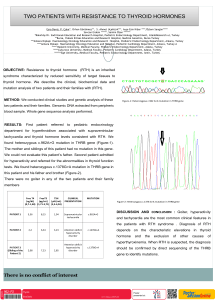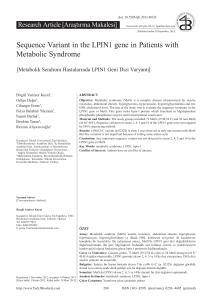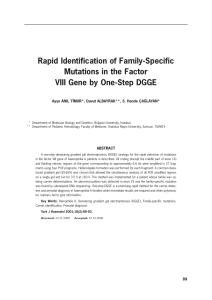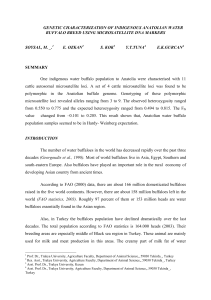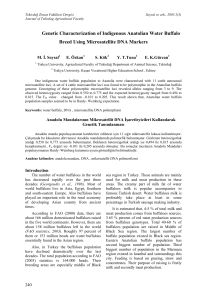İngilizce Başlık - İstanbul Üniversitesi
advertisement
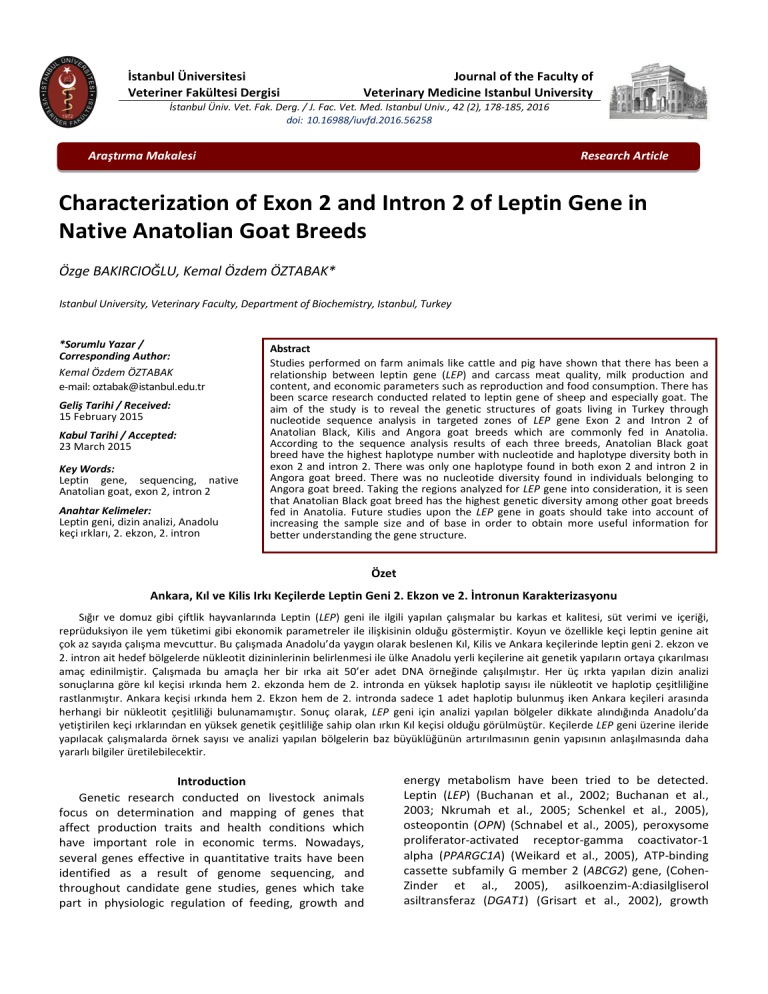
İstanbul Üniversitesi Veteriner Fakültesi Dergisi Journal of the Faculty of Veterinary Medicine Istanbul University İstanbul Üniv. Vet. Fak. Derg. / J. Fac. Vet. Med. Istanbul Univ., 42 (2), 178-185, 2016 doi: 10.16988/iuvfd.2016.56258 Araştırma Makalesi Research Article Characterization of Exon 2 and Intron 2 of Leptin Gene in Native Anatolian Goat Breeds Özge BAKIRCIOĞLU, Kemal Özdem ÖZTABAK* Istanbul University, Veterinary Faculty, Department of Biochemistry, Istanbul, Turkey *Sorumlu Yazar / Corresponding Author: Kemal Özdem ÖZTABAK e-mail: [email protected] Geliş Tarihi / Received: 15 February 2015 Kabul Tarihi / Accepted: 23 March 2015 Key Words: Leptin gene, sequencing, native Anatolian goat, exon 2, intron 2 Anahtar Kelimeler: Leptin geni, dizin analizi, Anadolu keçi ırkları, 2. ekzon, 2. intron Abstract Studies performed on farm animals like cattle and pig have shown that there has been a relationship between leptin gene (LEP) and carcass meat quality, milk production and content, and economic parameters such as reproduction and food consumption. There has been scarce research conducted related to leptin gene of sheep and especially goat. The aim of the study is to reveal the genetic structures of goats living in Turkey through nucleotide sequence analysis in targeted zones of LEP gene Exon 2 and Intron 2 of Anatolian Black, Kilis and Angora goat breeds which are commonly fed in Anatolia. According to the sequence analysis results of each three breeds, Anatolian Black goat breed have the highest haplotype number with nucleotide and haplotype diversity both in exon 2 and intron 2. There was only one haplotype found in both exon 2 and intron 2 in Angora goat breed. There was no nucleotide diversity found in individuals belonging to Angora goat breed. Taking the regions analyzed for LEP gene into consideration, it is seen that Anatolian Black goat breed has the highest genetic diversity among other goat breeds fed in Anatolia. Future studies upon the LEP gene in goats should take into account of increasing the sample size and of base in order to obtain more useful information for better understanding the gene structure. Özet Ankara, Kıl ve Kilis Irkı Keçilerde Leptin Geni 2. Ekzon ve 2. İntronun Karakterizasyonu Sığır ve domuz gibi çiftlik hayvanlarında Leptin (LEP) geni ile ilgili yapılan çalışmalar bu karkas et kalitesi, süt verimi ve içeriği, reprüduksiyon ile yem tüketimi gibi ekonomik parametreler ile ilişkisinin olduğu göstermiştir. Koyun ve özellikle keçi leptin genine ait çok az sayıda çalışma mevcuttur. Bu çalışmada Anadolu’da yaygın olarak beslenen Kıl, Kilis ve Ankara keçilerinde leptin geni 2. ekzon ve 2. intron ait hedef bölgelerde nükleotit dizininlerinin belirlenmesi ile ülke Anadolu yerli keçilerine ait genetik yapıların ortaya çıkarılması amaç edinilmiştir. Çalışmada bu amaçla her bir ırka ait 50’er adet DNA örneğinde çalışılmıştır. Her üç ırkta yapılan dizin analizi sonuçlarına göre kıl keçisi ırkında hem 2. ekzonda hem de 2. intronda en yüksek haplotip sayısı ile nükleotit ve haplotip çeşitliliğine rastlanmıştır. Ankara keçisi ırkında hem 2. Ekzon hem de 2. intronda sadece 1 adet haplotip bulunmuş iken Ankara keçileri arasında herhangi bir nükleotit çeşitliliği bulunamamıştır. Sonuç olarak, LEP geni için analizi yapılan bölgeler dikkate alındığında Anadolu’da yetiştirilen keçi ırklarından en yüksek genetik çeşitliliğe sahip olan ırkın Kıl keçisi olduğu görülmüştür. Keçilerde LEP geni üzerine ileride yapılacak çalışmalarda örnek sayısı ve analizi yapılan bölgelerin baz büyüklüğünün artırılmasının genin yapısının anlaşılmasında daha yararlı bilgiler üretilebilecektir. Introduction Genetic research conducted on livestock animals focus on determination and mapping of genes that affect production traits and health conditions which have important role in economic terms. Nowadays, several genes effective in quantitative traits have been identified as a result of genome sequencing, and throughout candidate gene studies, genes which take part in physiologic regulation of feeding, growth and energy metabolism have been tried to be detected. Leptin (LEP) (Buchanan et al., 2002; Buchanan et al., 2003; Nkrumah et al., 2005; Schenkel et al., 2005), osteopontin (OPN) (Schnabel et al., 2005), peroxysome proliferator-activated receptor-gamma coactivator-1 alpha (PPARGC1A) (Weikard et al., 2005), ATP-binding cassette subfamily G member 2 (ABCG2) gene, (CohenZinder et al., 2005), asilkoenzim-A:diasilgliserol asiltransferaz (DGAT1) (Grisart et al., 2002), growth 179 Bakırcıoğlu and Öztabak, J. Fac. Vet. Med. Istanbul Univ., 42 (2), 178-185, 2016 hormon gene (GH) (Hoj et al., 1993; Lucy et al., 1993), prolaktin gene (PRL) (Mitra et al., 1995) can be considered as examples for major effective genes that can be used to develop quantitative traits in livestock animals. Mammalian leptin produced by obese gene is a hormone consists of 167 amino acids and has a protein structure that contains 21 amino acid signal peptides in its amino terminal. Leptin secreted from adipocytes to circulation is a 14-16 kDa weighted molecule containing 146 amino acids (Ji et al., 1998; Zhang et al., 1994). It is reported that the amino acid sequencing of this obese gene (leptin gene) has high similarity rate among various types. Leptin is especially an effective hormone to feeding and to energy metabolism due to being effective in controlling the body energy balance. It is reported that circulating leptin hormone concentration in humans, rodents and ruminants is a reflection of body adipose tissue amount (Chilliard et al., 2001). It was also suggested that except from the feeding and energy metabolism of ruminants, leptin hormone is also effective on the body weight gain, reproduction, and immune functions (Block et al., 2001; Kadokawa et al., 2000; Santos-Alvarez et al., 1999). Anatolia (Akis et al., 2012). This study therefore aims to reveal the genetic structures of goats living in Turkey through nucleotide sequence analysis in target region of LEP gene exon 2 and intron 2 of Anatolian Black, Kilis and Angora goats which are widely bred in Anatolia. Materials and Methods DNA samples Although this study examines 50 pieces of DNA samples for each breed, only a few samples showed positive results related to goat breed and based on change over targeted region. DNA samples were selected from the collection comprised of the samples obtained by standard ammonium acetate salt-out method (Miller et al., 1988). The blood samples belonging to Angora goat were taken from breeders living in villages of Nallihan province of Ankara. The blood samples for Kilis goat were taken from villages of Kilis city centre, the blood samples for Anatolian Black goat were obtained from breeders living in villages in Izmir’s province of Menemen. LEP gene was found in mice in 1994 for the first time. Leptin is well characterized in human, laboratory rodents, livestock animals, sea calf, whale and fish. Obes gene (LEP gene) found in chromosome 7 in humans, chromosome 6 in mice (He et al., 1995; Isse et al., 1995; Zhang et al., 1994), chromosome 4 in sheep, cattle and goats (Stone et al., 1996) and chromosome 18 in pigs (Sasaki et al., 1996). It was reported by the researchers that single nucleotide polymorphisms (SNP) in LEP gene has interaction with economic parameters like carcass meat quality (Buchanan et al., 2002; Buchanan et al., 2003; Nkrumah et al., 2005; Schenkel et al., 2005), milk yield and content (Buchanan et al., 2003; Madeja et al., 2004; Silva et al., 2002), reproduction (Gonzalez et al., 2000) feeding (Lagonigro et al., 2003; Liefers et al., 2002; Nkrumah et al., 2005) in cattle and pig. According to the studies performed in sheep it was suggested that LEP gene has effect on growth traits and body weight (Shojaei et al., 2010). Due to Anatolia being one of the two well-known taming centres in the world, native breed goats grown up in this region have significant importance as genetic information source (Naderi et al., 2008). Although several candidate genes have been detected in goats until now, there has been little research conducted over revealing genetic infrastructure of goat breeds raised in Figure 1. Agorose Gel Electrophoresis of PCR products of 152 bp fragment of exon 2 of leptin gene. Lane 1: 100 bp DNA ladder (Gene RulerTM), Lane 2–10: PCR products of 152 bp fragment. Genotyping The PCR for exon 2 and Intron 2 of LEP gene was carried out in a final volume of 25µL containing 1 U Taq DNA polymerase (Fermantas Life Sciences, Canada), 22.5 µL 10XPCR buffer (750mM Tris-HCl (pH 8.0), 200mM (NH4)2SO4, 0.1% Tween 20), 1.5mM MgCl2, 50-100ng genomic DNA, 100µM dNTP (Takara, Biotechnology Co, Ltd, Japan) and 10 pmol of each primer. Primers, LEPexon2F: 5’TGCAGTCTGTCTCCTCCAAA3’ and LEP exon2R: 5’CGATAATTGGATCACATTTCTG3’, used to amplify 152 bp product include part of exon 2 of LEP gene (Figure 1) (GeneBank accession number: JQ 7399233) (Singh et al., 2009). Amplification condition was 95oC for 2 min; 30 cycles of 95oC for 1 min, 53 for 1 180 Bakırcıoğlu and Öztabak, J. Fac. Vet. Med. Istanbul Univ., 42 (2), 178-185, 2016 min, 720C for 1 min; and a final extension at 720C for 7 min. Primers, LEPintron2F:5’TGCAGTCTGTCTCCTCCAAA3’ and LEPintron2R: 5’CGATAATTGGATCACATTTCTG3’, used to amplify 400 bp product include part of exon intron 2 of LEP gene (Figure 2) (GeneBank accession number: JQ 7399233) (Singh et al., 2009). Amplification condition was 940C for 5 min; 35 cycles of 940C for 1 min, 58 for 1 min, 720C for 1 min; and a final extension at 720C for 10 min. Products were visualised by 2% agarose gel electrophoresis. Compare to Kilis, Angora goats and Anatolian Black goats, the highest levels of haplotype were found in Anatolian Black goat. Nucleotide diversity of Anatolian Black goat was also much higher than those of Kilis and Angora goats. Table 1. Values for Exon 2 LEP Gene of Anatolian Black, Kilis and Angora Goats. n1 h2 hd3 Π4 Anatolian black goat 39 3 0,101±0,065 0,073±0,047 Kilis goat 21 1 0,000±0.000 0,000±0.000 Angora goat 40 1 0,000±0.000 0,000±0.000 Animal number; 2Haplotype number; 3Haplotype diversity; 4Nucleotide diversity 1 Figure 2. Agorose Gel Electrophoresis of PCR products of 400 bp fragment of intron 2 of leptin gene. Lane 1: 100 bp DNA ladder (Gene RulerTM), Lane 2–10: PCR products of 400 bp fragment. Statistical Analyses Exon 2 and Intron 2 sequence analysis results of individuals from Anatolian Black, Kilis and Angora goat breeds were first evaluated via MEGA 4 software (program http://www.megasoftware.net/m_con_select.html), (Tamura et al., 2007). After analyses completed, the sequence analyses results of all three breeds were taken into account and data like haplotype number (h), haplotype diversity (Hd), and nucleotide diversity (Π) calculated via DnaSP v4.90.1 software program (http://www.ub.es/dnasp/), (Rozas et al., 2003). Results According to the result of the analyses, Exon 2 and Intron 2 sequence analysis results of individuals from all three goat breeds were first evaluated via MEGA 4 software program (http://www.megasoftware.net/m_con_select.html), (Tamura et al., 2007). Exon 2 nucleotide sequences of Anatolian Black, Kilis and Angora goats are given in Figure 3. Data related to animal number, haplotype number, haplotype diversity and nucleotide diversity of all three breeds are shown in Table 1. While three major haplotypes were observed in exon 2 region of leptin gene in Anatolian Black goats, there was only one haplotype observed in Kilis and Angora goats. Intron 2 nucleotide sequence of Anatolian Black, Kilis and Angora goats are given in Figure 4. Data related to animal number, haplotype number, haplotype diversity and nucleotide diversity of all three breeds are given in Table 2. As a result of the analysis carried out, it was observed that Anatolian Black goat among all three breeds has the highest number of haplotypes. In intron 2 of Anatolian Black goat, 4 haplotypes were identified. It is also identified that there is 2 haplotypes in intron 2 of Kilis goat, and one haplotype in intron 2 of Angora goat. Among all three breeds, it was found that Anatolian Black goats were found to have the highest diversity of haplotype. The lowest haplotype diversity was found in Angora goat. While the highest nucleotide diversity was found in Anatolian Black goat, the lowest nucleotide diversity was observed in Angora goat. Table 2. Values for Intron 2 LEP gene of Anatolian Black, Kilis and Angora Goats. n1 h2 hd3 Π4 Anatolian black goat 13 4 0,423±0,164 0,107±0,087 Kilis goat 32 2 0,063±0,058 0,032±0,030 Angora goat 10 1 0,000±0.000 0,000±0.000 Animal number; 2Haplotype number; 3Haplotype diversity; 4Nucleotide diversity 1 181 Bakırcıoğlu and Öztabak, J. Fac. Vet. Med. Istanbul Univ., 42 (2), 178-185, 2016 KHP1 KHP3 KHP13 KSHP1 AHP1 TGGGCTCACCCTCTCCTGAGTTTGTCCAGATGGACCAGACATTGGCAATC TGGGCTGCACCCTCTCCTGAGTTTGTCCAGATGGACCAGACATTGGCAATC TGGGCTGCACCCTCTCCTGAGTTTGTCCAGATGGACCAGATCCTTGGCAAT TGGGCTCACCCTCTCCTGAGTTTGTCCAGATGGACCAGACATTGGCAATC TGGGCTCACCCTCTCCTGAGTTTGTCCAGATGGACCAGACATTGGCAATC 50 51 51 50 50 KHP1 KHP3 KHP13 KSHP1 AHP1 TACCAACAGATCCTCGCCAGTCTGCCTTCCAGAAATGTGATCCAATTATCG TACCAACAGATCCTCGCCAGTCTGCCTTCCAGAAATGTGATCCAATTATC CTACCAACAGATCCTCGCCAGTCTGCCTTCCAGAAATGTGATCCAATTAT TACCAACAGATCCTCGCCAGTCTGCCTTCCAGAAATGTGATCCAATTATCG TACCAACAGATCCTCGCCAGTCTGCCTTCCAGAAATGTGATCCAATTATCG 101 101 101 101 101 Figure 3. Multiple sequence alignment, exon 2 of LEP gene in Anatolian Black, Kilis and Angora goat breeds (KHP: Anatolian black goat haplotype, KSHP: Kilis goat haplotype; AHP: Angora goat haplotype). KHP1 KHP2 KHP5 KHP12 KSHP1 KSHP8 GGTCTTCTGCATTGCAGGCGGATTCTTTACCATCTGAGCCACCAGGG GGTCTTCTGCATTGCAGGCGGATTCTTTACCATCTGAGCCACCAGGG GGTCTTCTGCATTGCAAGGCGGATTCTTTACCATCTGAGCCACCAGGG GGTCTTCTGCATTGCAGGCGGATTCTTTACCATCTGAGCCACCAGGG GGTCTTCTGCATTGCAGGCGGATTCTTTACCATCTGAGCCACCAGGG GGTCTTCTGCATTGCAGGCGGATTCTTTACCATCTGAGCCACCAGGG 47 47 48 47 47 47 KHP1 KHP2 KHP5 KHP12 KSHP1 KSHP8 AAACCCATAAGACCTTGTGAAGACTATTAAGATAGTCATCTAGACAA AAACCCATAAGACCTTGTGAAGACTATTAAGATAGTCATCTAGACAA AAACCCATAAGACCTTGTGAAGACTATTAAGATAGTCATCTAGACAA AAACCCATAAGACCTTGTGAAGACTATTAAGATAGTCATCTAGACAA AAACCCATAAGACCTTGTGAAGACTATTAAGATAGTCATCTAGACAA AAACCCATAAGACCTTGTGAAGACTATTAAGATAGTCATCTAGACAA 94 94 95 94 94 94 KHP1 KHP2 KHP5 KHP12 KSHP1 KSHP8 CAGGACTATCTTAATAGTCTTCATAAGGTCTTCATGAGACTAAATTAG CAGGACTATCTTAATAGTCTTCATAAGGTCTTCATGAGACTAAATTAG CAGGACTATCTTAATAGTCTTCATAAGGTCTTCATGAGACTAAATTAG CAGGACTATCTTAATAGTCTTCATAAGGTCTTCATGAGACTAAATTAG CAGGACTATCTTAATAGTCTTCATAAGGTCTTCATGAGACTAAATTAG CAGGCACTATCTTAATAGTCTTCATAAGGTCTTCATGAGACTAAATTAG 142 142 143 142 142 143 KHP1 KHP2 KHP5 KHP12 KSHP1 KSHP8 ATAAAGCAAGTGACCCTCCCTGCATACCCTTGCAGAACCAGAACTGTG ATAAAGCAAGTGACCCTCCCTGCATACCCTTGCAGAACCAGAACTGTG ATAAAGCAAGTGACCCTCCCTGCATACCCTTGCAGAACCAGAACTGTG ATAAAGCAAGTGACCCTCCCTGCATACCCTTGCAGAACCAGAACTGTG ATAAAGCAAGTGACCCTCCCTGCATACCCTTGCAGAACCAGAACTGTG ATAAAGCAAGTGACCCTCCCTGCATACCCTTGCAGAACCAGAACTGTG 190 190 191 190 190 191 KHP1 KHP2 KHP5 KHP12 KSHP1 KSHP8 TATGCCCTCTTTCAAGGTTTTCAGTCATAACTTTTGATAGCTTCCCACCT TATGCCCTCTTTCAAGGTTTTCAGTCATAACTTTTGATAGCTTCCCACCT TATGCCCTCTTTCAAGGTTTTCAGTCATAACTTTTGATAGCTTCCCACCT TCTGCCCTCTTTCAAGGTTTTCAGTCATAACTTTTGATAGCTTCCCACCT TATGCCCTCTTTCAAGGTTTTCAGTCATAACTTTTGATAGCTTCCCACCT TATGCCCTCTTTCAAGGTTTTCAGTCATAACTTTTGATAGCTTCCCACCT 240 240 241 240 240 241 Figure 4. Multiple sequence alignment, intron 2 of l LEP gene in Anatolian Black, Kilis and Angora goat breeds (KHP: Anatolian black goat haplotype, KSHP: Kilis goat haplotype; AHP: Angora goat haplotype). 182 Bakırcıoğlu and Öztabak, J. Fac. Vet. Med. Istanbul Univ., 42 (2), 178-185, 2016 KHP1 KHP2 KHP5 KHP12 KSHP1 KSHP8 TAAAAGCCAACTTGCTCACCTGCATGGAGCAATCTGGAGACTTCCACA TAAAAGCCAACTTGCTCACCTGCATGGAGCAATCTGGAGACTTCCACA TAAAAGCCAACTTGCTCACCTGCATGGAGCAATCTGGAGACTTCCACA TAAAAGCCAACTTGCTCACCTGCATGGAGCAATCTGGAGACTTCCACA TAAAAGCCAACTTGCTCACCTGCATGGAGCAATCTGGAGACTTCCACA TAAAAGCCAACTTGCTCACCTGCATGGAGCAATCTGGAGACTTCCACA 288 288 289 288 288 289 KHP1 KHP2 KHP5 KHP12 KSHP1 KSHP8 TCTCCTGACCACTCTATATTTCTAACAGTGGCTTTGGGCAGCCAGGG TCTCCTGACCACTCTATATTTCTAACAGTGGCTTTGGGCAGCCAGGG TCTCCTGACCACTCTATATTTCTAACAGTGGCTTTGGGCAGCCAGGG TCTCCTGACCACTCTATATTTCTAACAGTGGCTTTGGGCAGCCAGGG TCTCCTGACCACTCTATATTTCTAACAGTGGCTTTGGGCAGCCAGGG TCTCCTGACCACTCTATATTTCTAACAGTGGCTTTGGGCAGCCAGGG 335 335 336 335 335 336 KHP1 KHP2 KHP5 KHP12 KSHP1 KSHP8 AGAAGTTAGGTAGCCAGAAGCGGCGAC AGAAGTTAGGTAGCCAGAAGCGGGGAC AGAAGTTAGGTAGCCAGAAGCGGGGA AGAAGTTAGGTAGCCAGAAGCGGGGAC AGAAGTTAGGTAGCCAGAAGCGGGGAC AGAAGTTAGGTAGCCAGAAGCGGGGA 362 362 362 362 362 362 Figure 4. Continue. Discussion There were two single nucleotide polymorphisms observed in exon 2 (Buchanan et al., 2002; Lagonigro et al., 2003) and exon 3 (Lagonigro et al., 2003) in cattle which affect economical traits. Lindersson et al. (1998) suggested that there is a relationship between milk yield and leptin gene in cattle. Buchanan et al. (2002) and Gonzalez et al. (2000) claimed that there is a relationship between leptin gene and the meat production and reproduction. It was reported that there has been less research conducted on sheep leptin gene than on cattle leptin gene (Shojaei et al., 2010). Shojaei et al. (2010) detected polymorphism in the leptin gene in Kermani sheep. Identified variations are thought to be effective on activity and function of leptin. This study also tests whether there is any correlation between candidate gene and growth traits. As a result of Shojaei et al. (2010) study, it was observed that leptin gene plays an effective role for growth. The association between leptin polymorphism and growth traits in Kermani sheep shows that this gene can be used as the decisive criteria upon improving the body weight genetically (Shojaei et al., 2010). In this study, while there was only one haplotype found in exon 2 of leptin in Kilis and Angora goat breeds, there were three haplotypes found belonging to Anatolian Black goat. When the sequence analysis belonging to exon 2 region is compared, Anatolian Black goat breed nucleotide diversity was found as 0.073±0.047 and for Kilis and Angora goat breed nucleotide diversity was found as zero. Taking both haplotype number and nucleotide diversity into account, it can be suggested that Anatolian Black goats have more genetic diversity than the other two breeds. This difference may suppose be resulted from Anatolian Black goats being geographically more widespread than Angora and Kilis goat breeds (Kaymakçı, 2006; Porter, 1996; TAGEM, 2009). This geographic prevalence of Anatolian Black goat also provides an opportunity for gene transaction among different goat breeds. Because Anatolian Black goat has intense interaction with other goat breeds, this goat breed has rich gene pool and genetic diversity. In this case, Anatolian Black goats are supposed to have higher haplotype number and nucleotide diversity than the two other breeds. When the leptin gene exon 2 is evaluated based on nucleotide haplotype number and diversity, it was reported that Angora and Kilis goats have more protected structure than the Anatolian Black goat. Increase in samplings belonging to all three breeds can also lead to increase in identified haplotype number. Moreover, in the case of analysed target region in leptin gene exon 2 having too many base pairs, it can be suggested that nucleotide diversity which was found as zero in Angora and Kilis goats can result in an increase. Although, it has been reported in classic sources (Kaymakçı, 2006) that Kilis goat is a new breed appeared due to Anatolian Black and Damascus goat breeds being 183 Bakırcıoğlu and Öztabak, J. Fac. Vet. Med. Istanbul Univ., 42 (2), 178-185, 2016 fed together, this information was not supported by the findings of this research that reported unlike Anatolian Black goat, the haplotype number as 1 and nucleotide diversity as 0 for Kilis goat breed. Singh et al. (2009) identified 3 haplotypes for Barbari goat breed and 2 haplotypes for Jamunapari goat breed as a result of sequence analysis in Indian Barbari and Jamunapari goat breed leptin gene exon 2. Moreover, it was reported that nucleotide diversity in Barbari goat breed was found as 0.732±0.54 and in Jamunapari goat breed as 0.267±0.271. Although in these two breeds belonging to India, the haplotype numbers were similar to the Anatolian Black goat breed, nucleotide diversity of Anatolian Black goat breed was found to be at much lower levels than of those two breeds. This case therefore shows that genetic diversity of both Indian goat breeds are higher than genetic diversity of Anatolian Black goat breed. In this study, as a result of sequence analysis of leptin gene intron 2, the highest numbers of haplotypes and haplotype and nucleotide diversity were noted in Anatolian Black goats similar to as in exon 2 results. Unlike the results of exon 2, there were also 2 haplotypes found in Kilis goat breed. Even though the haplotype and nucleotide diversity were lower than the Anatolian Black goat, it was higher than Angora goat whose haplotype number was 1 and haplotype and nucleotide diversity was 0. It can be suggested that the reason this finding is different to the exon 2, may be due to the fact that the analysed target region in intron 2 contain more numbers of nucleotide pairs (400bp). The analysis result of this region also maintains the similar findings based on exon 2 analysis results which supports that Anatolian Black goat has more genetic diversity than the other two breeds. In other words, it maintains the idea that Kilis and especially Angora goat breeds have more protected genetic structure. Moreover, it should also be noted that if the sample size increased, there might be more numbers of haplotype found in all three breeds. As a result of leptin gene intron 2 analyses, Singh et al. (2009) found 3 and 4 haplotype in Barbari and Jamunapari goat breeds, respectively. Furthermore, they reported the nucleotide diversity in Barbari breed goat as 0.609±0.398 and nucleotide diversity in Jamunapari breed goat as 0.737±0.482. The rates found were almost close to the samples belonging to Anatolian Black goat in terms of both haplotype number and nucleotide diversity. In this case, when the size of base in target region in leptin gene exon 2 is increased, the haplotype number, and haplotype and nucleotide diversity in all three breeds are expected to increase. In conclusion, LEP gene exon 2 and intron 2 of Anatolian Black, Kilis and Angora goats widely bred in Anatolia were examined. The results showed that Anatolian Black goat is the breed with the highest genetic diversity in study region. Taking into account the widely breeding of Anatolian Black goat in anywhere in Anatolia for centuries, and their interaction with other breeds living in this region, leads to the idea that this breed has a very rich volume of gene pool and genetic diversity, which then also explain high genetic diversity of LEP gene is a plausible result. Further studies should take into account increasing the sample size and base size of the analysed region in order to have definitive results. Acknowledgments This study was supported by the Research Fund of Istanbul University, Project No: 32507. REFERENCES Akis, I., Oztabak, K., Gursel, F.E., Un, C., 2012. Goat agouti gene polymorphism and its association with coat color in indigenous Turkish goat breeds. Veterinary Medicine and Zootechnics 60, 3-6. Block, S.S., Butler, W.R., Ehrhardt, R.A., Bell, A.W., Van Amburgh, M.E., Boisclair, Y.R., 2001. Decreased concentration of plasma leptin in periparturient dairy cows is caused by negative energy balance. Journal of Endocrinology 171, 339-348. Buchanan, F.C., Fitzsimmons, C.J., Van Kessel, A.G., Thue, T.D., Winkelman-Sim, D.C., Schmutz, S.M., 2002. Association of a missense mutation in bovine leptin gene with carcass fat content and leptin mRNA levels. Genetics Selection Evolution 34, 105-116. Buchanan, F.C., Van Kessel, A.G., Waldner, C., Christensen, D.A., Laarveld, B., Schmutz, S.M., 2003. Hot Topic: An Association Between a Leptin Single Nucleotide Polymorphism and Milk and Protein Yield. Journal of Dairy Science 86, 3164-3166. Chilliard, Y., Bonnet, M., Delavaud, C., Faulconnier, Y., Leroux, C., Djiane, J., Bocquier, F., 2001. Leptin in ruminants. Gene expression in adipose tissue and mammary gland, and regulation of plasma concentration. Domestic Animal Endocrinology 21, 271-295. Cohen-Zinder, M., Seroussi, E., Larkin, D.M., Loor, J.J., Evertsvan der Wind, A., Lee, J.H., Drackley, J.K., Band, M.R., Hernandez, A.G., Shani, M., Lewin, H.A., Weller, J.I., Ron, M., 2005. Identification of missense mutation in the bovine ABCG2 gene with a major effect on the QTL on chromosome 6 affecting milk yield and composition in Holstein cattle. Genome Research 15, 936-944. González, R.R., Simón, C., Caballero-Campo, P., Norman, R., Chardonnens, D., Devoto, L., Bischof, P., 2000. Leptin and reproduction. Human Reproduction Update 6, 290-300. 184 Bakırcıoğlu and Öztabak, J. Fac. Vet. Med. Istanbul Univ., 42 (2), 178-185, 2016 Grisart, B., Coppieters, W., Farnir, F., Karim, L., Ford, C., Berzi, P., Cambisano, N., Mni, M., Reid, S., Simon, P., Spelman, R., Georges, M., Snell, R., 2002. Positional Candidate Cloning of a QTL in Dairy Cattle: Identification of Missense Mutation in the Bovine DGAT1 Gene with Major Effect on Milk Yield and Composition. Genome Research 12, 222-231. He, Y., Chen, H., Quon, M.J., Reitman, M., 1995. The Mouse obese Gene. The Journal of Biological Chemistry 270, 28887-28891. Høj, S., Fredholm, M., Larsen, N.J., Nielsen, V.H., 1993. Growth hormone gene polymorphism associated with selection for milk fat production in lines of cattle. Animal Genetics 24, 91-96. Isse, N., Ogawa, Y., Tamura, N., Masuzaki, H., Mori, K., Okazaki, T., Satoh, N., Shigemoto, M., Yoshimasa, Y., Nishi, S., Hosoda, K., Inazawa, J., Nakao, K., 1995. Structural Organization and Chromosomal Assignment of the Human obese Gene. The Journal of Biological Chemistry 270, 27728-27733. Ji, S., Willis, G.M., Scott, R.R., Spurlock, M.E., 1998. Partial cloning and expression of the bovine leptin gene. Animal Biotechnology 9, 1–14. Kadokawa, H., Blache, D., Yamada,Y., Martin, G.B., 2000. Relationships between changes in plasma concetrations of leptin before and after parturition and the timing of first post-partum ovulation in highproducing Holstein dairy cows. Reproduction, Fertility and Development 12, 405-411. Kaymakçı, M., 2006. Keçi yetiştiriciliği. İzmir ili damızlık koyunkeçi yetiştiricileri birliği yayınları, No:2, Bornova, İzmir, Türkiye. Lagonigro, R., Wiener, P., Pilla, F., Woolliams, J.A., Williams, J.L., 2003. A new mutation in the coding region of the bovine leptin gene associated with feed intake. Animal Genetics 34, 371-374. Liefers, S.C., te Pas, M.F.W., Veerkamp, R.F., van der Lende, T., 2002. Associations between Leptin Gene Polymorphisms and Production, Live Weight, Energy Balance, Feed Intake, and Fertility in Holstein Heifers. Journal of Dairy Science 85, 1633-1638. Lindersson, M., Andersson-Eklund, L., De Koning, D.J., Lundén, A., Maki-Tanila, A., Andersson, L., 1998. Mapping of Serum Amylase-1 and Quantitative Trait Loci for Milk Production Traits to Cattle Chromosome 4. Journal of Dairy Science 81, 1454-1461. Lucy, M.C., Hauser, S.D., Eppard, P.J., Krivi, G.G., Clark, J.H., Bauman, D.E., Collier, R.J., 1993. Variants of somatotropin in cattle: gene frequencies in major dairy breeds and associated milk production. Domestic Animal Endocrinology 10, 325-333. Madeja, Z., Adamowicz, T., Chmurzynska, A., Jankowski, T., Melonek, J., Switonski, M., Strabel, T., 2004. Short Communication: Effect of Leptin Gene Polymorphisms on Breeding Value for Milk Production Traits. Journal of Dairy Science 87, 3925-3927. Miller, S.A., Dykes, D.D., Polesky, H.F., 1988. A simple salting out procedure for extracting DNA from human nucleated cells. Nucleic Acids Research 16, 1215. Mitra, A., Schlee, P., Balakrishnan, C.R., Pirchner, F., 1995. Polymorphisms at growth-hormone and prolactin loci in Indian cattle and buffalo. Journal of Animal Breeding and Genetics 112, 71-74. Naderi, S., Rezaei, H.R., Pompanon, F., Blum, M.G.B, Negrini, R., Naghash, H.R., Balkız, Ö., Mashkour, M., Gaggiotti, O.E., Ajmone-Marsan, P., Kence A., Vigne, J.D., Taberlet, P., 2008. The goat domestication process inferred from large-scale mitochondrial DNA analysis of wild and domestic individuals. Proceeding of the National Academy of Sciences of the United States of America 105, 17659-17664. Nkrumah, J.D., Li, C., Yu, J., Hansen, C., Keisler, D.H., Moore, S.S., 2005. Polymorphism in the bovine leptin promoter associated with serum leptin concentration, growth, feed intake, feeding behavior, and measures of carcass merit. Journal of Animal Science 83, 20-28. Porter, V., 1996. Goats of the world. Farming press, Ipswich, UK. Rozas, J., Sánchez-DelBarrio, J.C., Messeguer, X., Rozas, R., 2003. DnaSP, DNA polymorphism analyses by the coalescent and other methods. Bioinformatics 19, 2496-2497. Santos-Alvarez, J., Goberna, R., Sánchez-Margalet, V., 1999. Human Leptin Stimulates Proliferation and Activation of Human Circulating Monocytes. Cellular Immunology 194, 6-11. Sasaki, S., Clutter, A.C., Pomp, D., 1996. Assignment of the porcine obese (leptin) gene to Chromosome 18 by linkage analysis of a new PCR-based polymorphism. Mammalian Genome 7, 471-472. Schenkel, F.S., Miller, S.P., Ye, X., Moore, S.S., Nkrumah, J.D., Li, C., Yu, J., Mandell, I.B., Wilton, J.W., Williams, J.L., 2005. Association of single nucleotide polymorphisms in the leptin gene with carcass and meat qality traits of beef cattle. Journal of Animal Science 83, 2009-2020. Schnabel, R.D., Kim, J.J., Ashwell, M.S., Sonstegard, T.S., Van Tassell, C.P., Connor, E.E., Taylor, J.F., 2005. Finemapping milk production quantitative trait loci on BTA6: Analysis of bovine osteopontin gene. Proceedings of the National Academy of Sciences of the United States of America 102, 6896-6901. Shojaei, M., Abadi, M.M., Fozi, M.A., Dayani, O., Khezri, A., Akhondi, M., 2010. Association of growth trait and Leptin gene polymorphism in Kermani sheep. Journal of Cell and Molecular Research 2, 67-73. Singh, S.K., Rout, P.K., Agarwal, R., Mandal, A., Singh, S.K., Shukla, S.N., Roy, R., 2009. Characterization of Exon 2 and Intron 2 of Leptin Gene in Indian Goats. Animal Biotechnology 20, 80-85. Silva, L.F.P., VandeHaar, M.J., Weber Nielsen, M.S., Smith, G.W., 2002. Evidence for a Local Effect of Leptin in Bovine Mammary Gland. Journal of Dairy Science 85, 3277-3286. Bakırcıoğlu and Öztabak, J. Fac. Vet. Med. Istanbul Univ., 42 (2), 178-185, 2016 Stone, R.T., Kappes, S.M., Beattie, C.W., 1996. The bovine homolog of the obese gene maps to Chromosome 4. Mammalian Genome 7, 399-400. TAGEM, 2009. Türkiye Evcil Hayvan Genetik Kaynakları Tanıtım Kataloğu. T.C. Tarım ve Köyişleri Bakanlığı Tarımsal Araştırmalar Genel Müdürlüğü, Ankara, pp.74-81. Tamura, K., Dudley, J., Nei, M., Kumar, S., 2007. MEGA4: Molecular Evolutionary Genetics Analysis (MEGA) Software Version 4.0. Molecular Biology and Evolution 24, 1596-1599. 185 Weikard, R., Kühn, C., Goldammer, T., Freyer, G., Schwerin, M., 2005. The bovine PPARGC1A gene: molecular characterization and association of an SNP with variation of milk fat synthesis. Physiological Genomics 21, 1-13. Zhang, Y., Proenca, R., Maffei, M., Barone, M., Leopold, L. Friedman, J.M., 1994. Positonal cloning of the mouse obese gene and its human homologue. Nature 372, 425-432.
